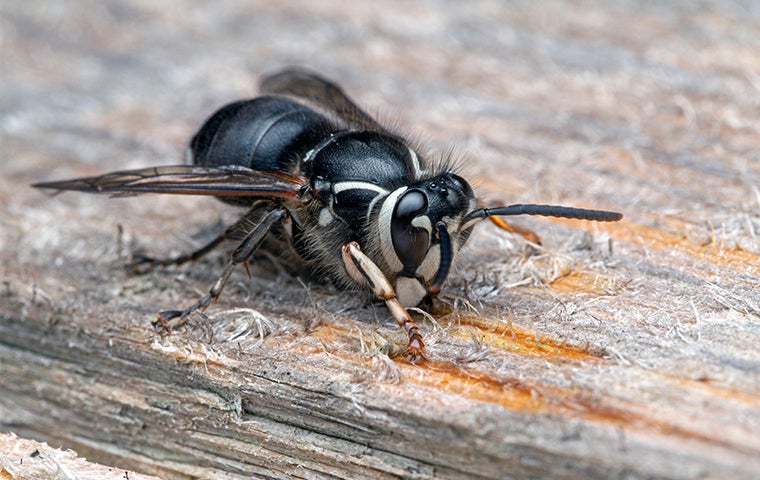The bald-faced hornet isn’t actually a hornet at all. Confusing, right? It would be more fitting to call it the bald-faced wasp, or better yet, the bald-faced yellow jacket. However, it is commonly referred to as a hornet due to its large size and aggressive nature.
Whatever you call them, bald-faced hornets can be trouble for homeowners. These wasps may decide that your North Carolina yard is a great place to start a colony. Soon you could have a large nest hanging from a tree, or worse yet, your roof!
These wasps pack a painful sting and often sting repeatedly when their nest is threatened. Protect yourself by learning how to identify bald-faced hornets, where you may find a nest, and how to deter and get rid of them.
Is This A Bald-Faced Hornet?
Bald-faced hornets are large stinging insects you may encounter on your property. Technically, they are not hornets but are actually a type of aerial yellow jacket. They are also known as white-faced hornets, white-tailed hornets, black jackets, bull wasps, and bald-faced yellow jackets.
Bald-faced hornets can be most easily differentiated from other types of stinging insects by the white pattern on their faces. Their bodies are black with white patches on their thoraxes and white stripes on their abdomens. Bald-faced hornets are relatively large, with workers measuring ½ to ⅝ inch long. Queens are even larger at around ¾ inch.
If you have identified bald-faced hornets in your yard, keep your distance from the insects and their nests. Bald-faced hornets can be aggressive and may sting repeatedly.
Ways To Deter Bald-Faced Hornets
Bald-faced hornets may decide to move into your yard, especially if it offers ideal nesting sites and access to food and water. Keeping bald-faced hornets away can be challenging, but there are a few things you can do to deter them. Check out these simple wasp prevention tips:
- Keep food covered while eating outdoors.
- Seal any cracks or spaces in the exterior of your home to keep bald-faced hornets from entering or nesting.
- Avoid wearing perfume, cologne, and other scented products that can attract stinging insects.
- Keep outdoor trash receptacles secured with tight-fitting lids.
- Reduce flowering vegetation in your yard.
Taking these steps can help reduce bald-faced hornets and other flying insects that sting on your property, but they may still construct nests in your yard. Next up, learn how to identify bald-faced hornet nests and where you’re likely to find them.
Where Is The Bald-Faced Hornet Nest On My Property?
Bald-faced hornets, like many other types of wasps, construct nests by mixing their saliva with cellulose from wood, which forms a paper-like material. The nests start small but expand as the colonies grow larger, eventually measuring up to 18 inches across and 24 inches long. Bald-faced hornet nests appear as gray, football-shaped structures hanging from tree limbs, shrubs, or other elevated places. Nests typically house between 100 and 400 individuals at their peak.
Bald-faced hornet nest construction begins in the spring when the fertilized queen emerges from her overwintering site. She begins the process of building the nest and laying eggs. When the first brood hatches, the workers take over and expand the nest, gather food, and defend the colony. More and more workers hatch and the nest grows throughout the summer.
If you have seen bald-faced hornets in your yard, there is likely a nest nearby. Nests are usually built at least three feet off the ground, often from high tree branches. They may be difficult to spot, as they can be hidden in the dense canopy of trees. Bald-faced hornet nests may also be located in shrubs or hanging from man-made structures such as eaves, overhangs, and utility poles.
When you locate a bald-faced hornet nest, do not approach it or attempt to knock it down. The workers protecting the nest will become aggressive and sting repeatedly. It is best to contact a professional who can safely treat and remove the nest.
Professional Pest Control To Help With Bald-Faced Hornets
Bald-faced hornet nests on your property could put you and your family at risk of being stung. These wasps often sting multiple times when defending their colony. The stings are painful for anyone but are especially concerning for those allergic to wasp venom. When dealing with stinging insects, it’s always safest to hire a professional pest control service.
Innovative Pest Solutions is your source for effective wasp removal. Our technicians are trained and experienced in addressing issues with bald-faced hornets and other stinging insects. We will locate and treat the nests on your property to eliminate bald-faced hornets and keep your family safe.
Get rid of bald-faced hornets with our stinging insect control services. Contact Innovative Pest Solutions for your complimentary inspection today.





